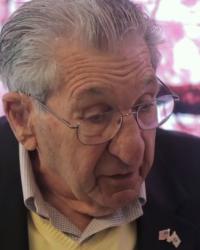Lester Tenney (1920-2017) was an American World War II veteran who survived the Bataan Death March and endured years as a prisoner of war in Japan. He later worked to obtain apologies from Japan for mistreatment of POWs during the war and to promote reconciliation between the U.S. and Japan.
Deployment to the Philippines
Tenney joined the 192nd Tank Battalion of the National Guard in 1940 and was deployed to the Philippines in 1941. He served as a radio operator and tank commander and participated in the first U.S. tank battle of the war against the Japanese near Lingayen. After U.S. troops fell back to the Bataan peninsula, Tenney participated in months of desperate fighting before U.S. forces surrendered to the Japanese on April 9, 1942.
Bataan Death March & Years As a POW
Tenney survived the Bataan Death March, where he and his fellow soldiers were forced to trek approximately 75 miles, with thousands dying from starvation, dehydration, and gratuitous violence. He then endured 32 days in a “hell ship” that transported him to Japan. He was forced to labor for three years in a coal mine for the Mitsui Coal Mining Company.
Tenney recalled witnessing the atomic bombing of Nagasaki: “We were in our prison camp in Omuta. We heard an explosion and we saw a tremendous cloud rise. It was the bomb at Nagasaki that we heard. I guess we were witnesses to it because we were right there. We didn’t know what it was. But the war ended one week later.” After returning home, Tenney discovered that his wife, presuming he had died, had remarried.
Later Years
Tenney received business degrees from San Diego State University and the University of Southern California and became a college professor. He also spearheaded a movement that pushed Japan to acknowledge the mistreatment of American POWs during World War II. In addition to calling for apologies from the Japanese government and Japanese mining companies, Tenney made enormous efforts to educate both Japanese schoolchildren and American society on what had happened during the war. In 1995, he published an account of his wartime experiences in a book called “My Hitch in Hell.”
Tenney remarked that all the while he pursued these apologies, he had come to realization that he had to forgive. “I couldn’t go there and talk with them if I hadn’t learned to forgive and get on with my life. So, the forgiveness that I did was not for them. The forgiveness was for me,” he explained. “By my forgiving, I opened up my door. I’ve often said that my friends who still hate, they’re still prisoners. They’re still prisoners. They have not been released yet.”
In addition to those efforts, he also formed a company called Care Packages from Home, which sends care packages to soldiers in Iraq and Afghanistan, after realizing he had never received his own package as a soldier.
For more about Tenney and his life, see his obituary in the San Diego Union-Tribune.





